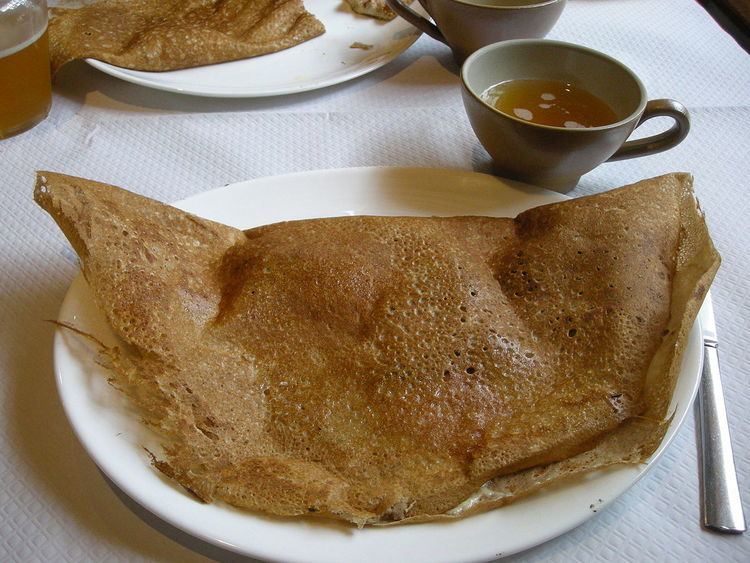 | ||
France
Brittany
According to the legend, the buckwheat pancake was born thanks to a Breton woman act of clumsiness that would have spilled a buckwheat slop on a hot pebble in the chimney. Since the XIIe century we can find small quantities of buckwheat pollen in the peat lands in Brittany.
The buckwheat culture appeared in Brittany at the beginning of the XVIe century: its output is irregular and low, but it’s not taxed, although it grows on poor grounds and it gives the possibility to harvest in three months. That’s why it’s called “the 100 days plant”. Among many legends about Anne de Bretagne, it is said that she developed its culture. Currently, the local production of buckwheat doesn’t allow to supply the 15 000 ton consumed per year in France, the preparation of the buckwheat pancake call on products from China, Poland and Canada’s importation. A “protected geographic indicator” exists for the Brittany buckwheat flour and the society “Blé noir tradition Bretagne” gathers more than 800 producers and around ten millers in order to promote the buckwheat flour use (4000 tons per year).
Korea
Memilbuchimgae
Memilbuchimgae is a variety of buchimgae, or Korean pancake. It is a crepe-like dish made of thin buckwheat batter and napa cabbage.
Along with other buckwheat dishes, memilbuchimgae is a traditional local specialty of Gangwon Province, where buckwheat is extensively cultivated due to its cooler mountainous climate. Especially Pyeongchang and Jeongseon Counties are famous for buckwheat dishes such as memilbuchimgae(buckwheat pancake), memilmuk(buckwheat jelly) and memilguksu(buckwheat noodles). Pyeongchang's biggest local festival was called Memilbuchigi festival before it was renamed Pyeongchang Festival in 2015. (Memilbuchigi means memilbuchimgae in Gangwon dialect.) Numerous memilbuchimgaes can be seen in Pyeongchang Market, a farmers' market held in Pyeongchang every five days.
Memiljeonbyeong
Memiljeonbyeong is a half-moon shaped buckwheat pancake with filling.
Slavic countries
A blini (sometimes spelled bliny) or, rarely, blin (more accurate as a single form of the noun) is a thin pancake, traditionally made from buckwheat flour and served with sour cream, butter, caviar, and other garnishes.
Blinis were considered by early Slavic people in pre-Christian times to be a symbol of the sun, due to their round form. They were traditionally prepared at the end of winter to honor the rebirth of the new sun (Butter Week, or Maslenitsa, also called "pancake week"). This tradition was adopted by the Orthodox church and is carried on to the present day. Blini were also served at wakes to commemorate the recently deceased.
Traditional Russian blinis are made with yeasted batter, which is left to rise and then diluted with cold or boiling water or milk. When diluted with boiling water, they are referred to as zavarniye bliny. Traditionally, blinis are baked in a Russian oven. The process of preparing blinis is still referred to as baking in Russian, even though they are nowadays pan-fried, like pancakes. French crêpes made from unyeasted batter (usually made of flour, milk, and eggs) are also common in Russia. All kinds of flour is used, from wheat and buckwheat to oatmeal and millet, although wheat is currently the most popular.
Blinis were popularized in the United States by Eastern European Jewish immigrants who used them in Jewish cuisine. While not part of any specific religious rite in Judaism, blinis stuffed with a cheese filling and then fried in oil are served on holidays such as Chanukah (as oil played a pivotal role in the miracle of the Chanukah story) and Shavuot (when dairy dishes are traditionally served within the Ashkenazi minhag). Blinis, also called "blinchiki" in Russian, are ordinarily stuffed before frying a second time. Fillings include chocolate, mushrooms, meat, rice, mashed potatoes, and cheese.
